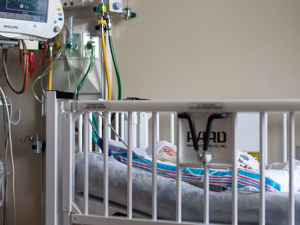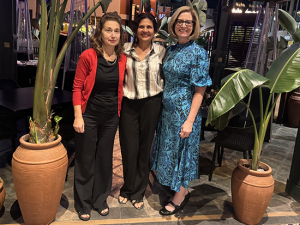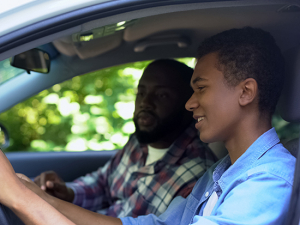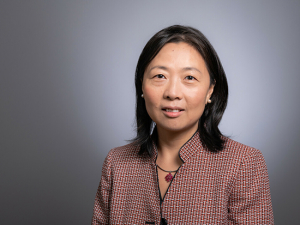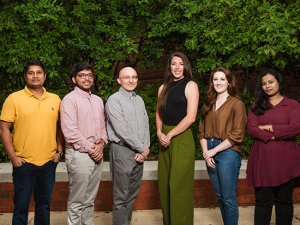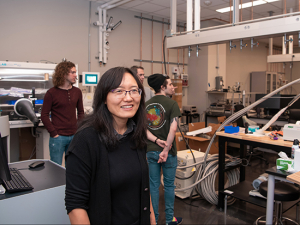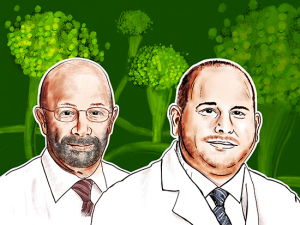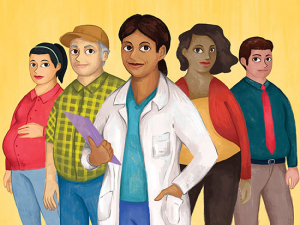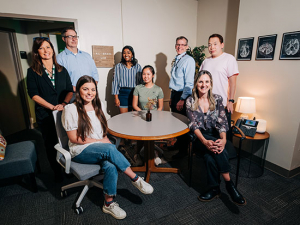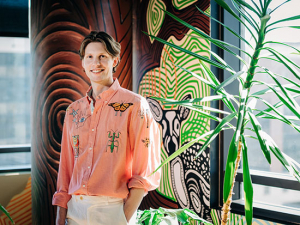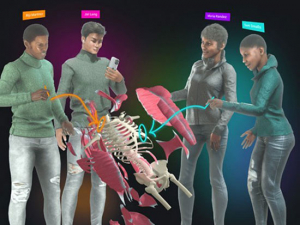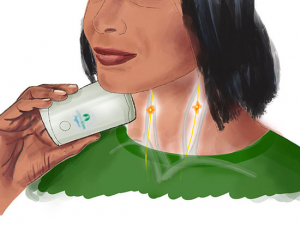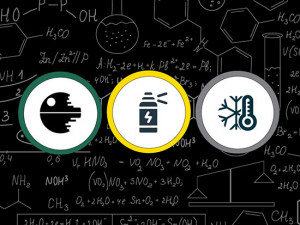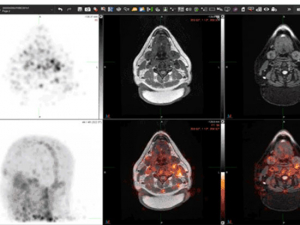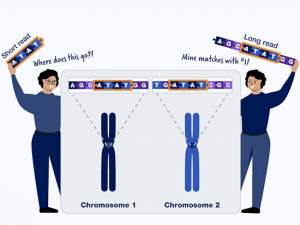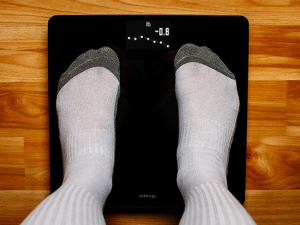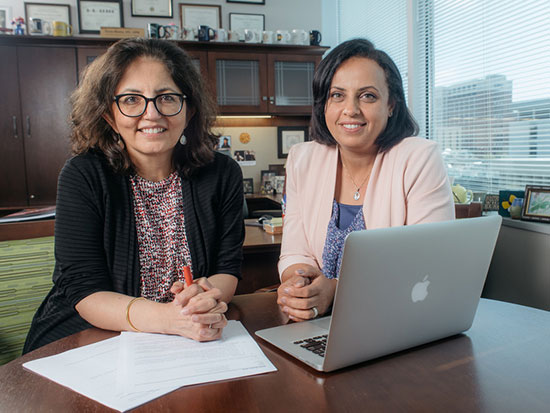 Noha Sharafeldin (right) used machine learning to identify genetic mutations that can help predict which patients with cancer will experience cognitive difficulties after a bone and marrow transplant. The work relies on the patient cohort built by her mentor, Smita Bhatia (left), director of UAB's Institute for Cancer Outcomes and Survivorship.Something happens in the months and years after cancer patients receive a blood or marrow transplant (BMT) from donor cells. Rather, for about a third of those patients, something doesn’t happen.
Noha Sharafeldin (right) used machine learning to identify genetic mutations that can help predict which patients with cancer will experience cognitive difficulties after a bone and marrow transplant. The work relies on the patient cohort built by her mentor, Smita Bhatia (left), director of UAB's Institute for Cancer Outcomes and Survivorship.Something happens in the months and years after cancer patients receive a blood or marrow transplant (BMT) from donor cells. Rather, for about a third of those patients, something doesn’t happen.
Even as they recover from the exhausting BMT procedure — which obliterates their body’s own, faulty blood cell machinery and then holds their immune systems in a straitjacket while the donor cells establish themselves — their brains just don’t seem to return to normal.
“Patients use the phrase ‘chemo brain,’” said Noha Sharafeldin, MBBCh, Ph.D., a faculty member in UAB’s Institute for Cancer Outcomes and Survivorship and the Division of Hematology and Oncology and an associate scientist with the O’Neal Comprehensive Cancer Center at UAB. Another common name is “the fog” — the forgetfulness, fuzzy-headedness and general sense that they just don’t think like they used to. “It’s not dementia, but mild to moderate cognitive impairment,” Sharafeldin said. “They feel foggy, become forgetful. They say they’re not up to keeping up with appointments and medications. It hinders their ability to go and function in the workplace.”
A new study by Sharafeldin at UAB is pointing to a better method of identifying patients at highest risk of cognitive problems after BMT, and her work was highlighted at the American Society for Clinical Oncology’s annual meeting in June. Now she is testing an innovative therapy to bring brains back from the fog — computer games.
Two ways to transplant
There are two ways to do BMT: with your own cells (autologous) or with someone else’s (allogeneic). It is no fun to have your bone marrow harvested. But getting someone else’s is worse. If it’s happening at all, it means that your marrow, the spongy tissue found in your hips, thighs and certain other bones, isn’t functioning properly. Most likely, you have a cancer or other blood disease that has reached an advanced stage. Bone marrow transplants are used with acute myeloid leukemia, lymphoma and multiple myeloma, for example.
Patients who are able can donate their own cells in advance, which has the advantage that the immune system won’t attack the transplanted cells. But many patients must rely on donated cells, which means they have to take strong drugs to stop their immune systems from rejecting the new cells.
In 2018, Sharafeldin and colleagues showed that patients who have allogeneic (donated cell) transplants are at significantly higher risk of cognitive effects compared with patients who receive their own cells. In the study, published in the Journal of Clinical Oncology, “we showed that up to 36 percent of patients who had allogeneic transplants had cognitive issues up to three years after the transplant,” Sharafeldin said. “We also looked at societal reintegration and found that patients with cognitive impairment were at a 10-fold higher risk of not going back to work.”
Older male patients, as well as those with low income and low cognitive reserve, were most at risk, Sharafeldin said. (“You can think of cognitive reserve as your brain’s ability to improvise and find alternate ways of getting a job done,” Harvard researchers explain.) “When you go in with a lower IQ,” Sharafeldin said, “that puts you at a higher risk.”
What can we do?
But those factors alone aren’t enough to predict which patients will end up with cognitive difficulties. “So we asked, is there something in our genes that is putting some patients at more risk?” Sharafeldin said. “We want to identify patients at high risk of cognitive impairment so we can target them with interventions. We’re trying to come up with a risk-prediction tool.”
That’s because the Institute for Cancer Outcomes and Survivorship, led by Smita Bhatia, M.D., professor and vice chair for Outcomes in the Department of Pediatrics, is committed to changing outcomes for cancer patients, Sharafeldin said.
But finding changes among the billions of “letters” in the body’s DNA code is a Herculean task. Especially when you have to correlate those changes across hundreds of patients. This isn’t the kind of job that can be done on a laptop. There are trillions of variables to sift, so Sharafeldin turned to machine-learning approaches and to Cheaha, UAB’s supercomputer, which recently was upgraded to take on just such gnarly machine-learning tasks.
| A new study at UAB is pointing to a better method for identifying patients at highest risk of cognitive problems after BMT. |
Machine-learning “is where the field is really going because the data is very complex, and the more complex it gets you have to adapt,” Sharafeldin said. “If you look at the landscape, the field is relying more and more on artificial intelligence and machine-learning techniques.”
Where could it be?
The UAB researchers started out by making an educated guess about the types of genes that could be involved. Then Sharafeldin programmed a machine-learning model to see if it could find patterns of mutations in those candidate genes among patients who experienced cognitive impairments after bone marrow transplant — and not in patients whose brain function remained intact. The work relied on a large cohort of patients who had been followed for years after their blood or marrow transplants at the City of Hope cancer center in California. Bhatia created that cohort at City of Hope and together with Sharafeldin is now developing a new cohort at UAB. (See “What happens after cancer is gone?” below.)
“We trained our machine-learning model on the patient data from City of Hope,” to identify genetic variants involved with cognitive impairment, Sharafeldin said. Then they tested its accuracy using a technique called elastic net regression to predict cognitive impairment. The UAB patient cohort will serve for future validation of these findings.
The researchers identified a recurring set of single nucleotide polymorphisms, known as SNPs, in patients with cognitive impairment. These SNPs — in which a single letter of the DNA code differs from the one found in most humans — were in key DNA repair genes, genes on the blood-brain barrier and genes involved in telomere homeostasis. “Then we used that data to build three risk-prediction models,” Sharafeldin said.
The first was based on age, sex, education, income and marital status — “the basic sociodemographic information you get in the clinic,” Sharafeldin said. Next, over and above that information, “we added in clinical information such as primary diagnosis, conditioning treatments (chemo and radiation), whether they’re in remission or not, levels of fatigue and cognitive reserve,” Sharafeldin said.
| Support the work of the Institute for Cancer Outcomes and Survivorship |
The final model added in genetic data identified by the machine-learning model. “We showed that yes, including the genetic variants in the model improved the risk-prediction significantly,” Sharafeldin said. “Performing a SNP test can enhance our ability to identify patients at risk.
“That’s really exciting,” Sharafeldin said. "It’s telling us we can eventually use that information in a clinical way. It’s precision medicine. The idea is the technology is there and evolving rapidly and the cost is going down. It’s going to become affordable. And the beauty of this paradigm is we can one day translate that right into the clinic. What we envision is a custom array with a few selected SNPs that can help us in the clinic in addition to the other information we already collect.”
Games for brains
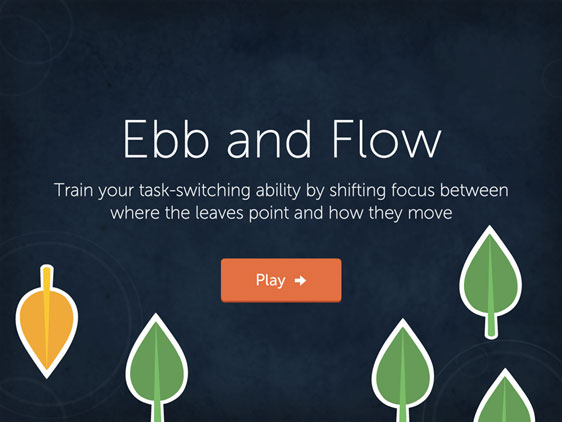
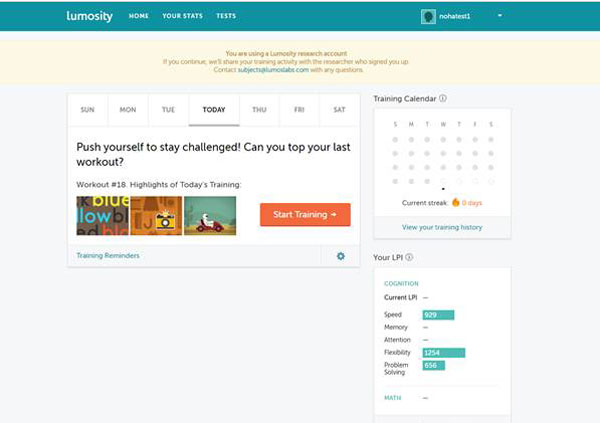 One promising way to reduce cognitive impairment is through brain games. In a clinical trial, researchers at the Institute for Cancer Outcomes and Survivorship are testing cognitive training in patients post-bone and marrow transplant. The study site, which uses brain training games from Lumosity, and one of the game screens are shown above. The goal isn’t to find patients just so they can give them the bad news that they may face cognitive impairment. “Cancer treatments are improving, and patient survival rates are increasing,” Sharafeldin said. “What we’re focused on is management of outcomes, once the patient goes out of treatment and is a survivor. That’s really where we want to make an impact.”
One promising way to reduce cognitive impairment is through brain games. In a clinical trial, researchers at the Institute for Cancer Outcomes and Survivorship are testing cognitive training in patients post-bone and marrow transplant. The study site, which uses brain training games from Lumosity, and one of the game screens are shown above. The goal isn’t to find patients just so they can give them the bad news that they may face cognitive impairment. “Cancer treatments are improving, and patient survival rates are increasing,” Sharafeldin said. “What we’re focused on is management of outcomes, once the patient goes out of treatment and is a survivor. That’s really where we want to make an impact.”
For patients in the fog, the question is, “what intervention strategies can we offer?” Sharafeldin said. "So far the evidence is pointing toward cognitive training — essentially, playing brain games.” Specialized companies such as Lumosity and even gaming giants such as Nintendo, with its Brain Age software line, have developed games meant to tap into the brain’s plasticity and build mental skills.
“The hypothesis is that patients playing these games improve their cognitive function and hopefully that can be translated into day-to-day life,” Sharafeldin said. She is enrolling allogeneic transplant patients who have received a bone marrow transplant at UAB in a clinical trial. All are at least three months post-transplant. “That’s the most critical time,” Sharafeldin said. “Around the 100-day mark is when patients are feeling better and back home.”
The researchers measure each patient’s cognitive function at baseline and then randomize them into an active arm or a waitlist. Patients in the active arm use cognitive training — a specifically tailored set of Lumosity games, on a research study site — for 12 weeks, six days a week, 30 minutes a day. After 12 weeks, they get another cognitive measurement from both groups. Then “we compare them and see if the program works," Sharafeldin said.
A pilot focused on feasibility, which looked at participation and adherence rates, had promising results. That led to a five-year grant from the Be the Match Foundation "to run the full intervention,” Sharafeldin said. “We’re going to enroll up to 150 patients to be able to answer the efficacy question.”
The researchers also hope to identify specific mechanistic changes. “We want to figure out as we go along what are the mechanisms underlying any improvement we see,” Sharafeldin said. The researchers are using MRI scans with a subset of patients “to examine their brain connectivity.”
Cognitive rehabilitation therapies have already proven effective at helping improve driving behavior in older adults and a range of other outcomes, including at UAB. "The reason we picked what we did is that it is something that can easily be applied in real life,” Sharafeldin said. “All you need is a computer and internet connection.”
The same methodological expertise and approach could find patterns that can be applied to other cancers and conditions, Sharafeldin said. “We are constantly looking for what works and applying that to our patients.”
